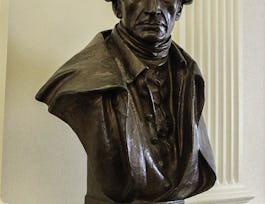This course will highlight the construction and interpretation of the U.S. Constitution through the centuries. You'll learn the history behind the Constitution, cases that formed important precedent, and how changes in interpretation have been dependent on shifts in cultural and political climate as well as the composition of the Supreme Court.



Chemerinsky on Constitutional Law - The Structure of Government

Instructor: Erwin Chemerinsky
Sponsored by Coursera Learning Team
14,345 already enrolled
(88 reviews)
Details to know

Add to your LinkedIn profile
5 assignments
See how employees at top companies are mastering in-demand skills


Earn a career certificate
Add this credential to your LinkedIn profile, resume, or CV
Share it on social media and in your performance review

There are 7 modules in this course
What's included
2 videos3 readings
In this module, we'll examine two facets of the critical question, "Why the Constitution?" First we'll answer the question, "what functions does the Constitution perform?" We'll then consider the question, "why achieve these functions in the form of a written Constitution?"
What's included
5 videos1 reading1 assignment1 peer review
What is the authority of judicial review? Why is it important? If the federal judiciary can declare a statute or action unconstitutional, what checks are there on this power? These are several of the questions we will endeavor to answer in this module.
What's included
7 videos1 reading1 assignment1 peer review
In this module we will consider three major questions: 1.How did McCullough vs. Maryland shape the power of the legislature? 2. What are the major powers of the Congress under the Constitution? 3. To what extent do states limit the power of the Congress?
What's included
8 videos1 reading1 assignment
The central questions in this module are: 1. When can a president act without express Constitutional or Congressional authority? 2. What are the Constitutional problems posed by the federal administrative agencies? 3. What is the authority of the President with regard to foreign policy?
What's included
5 videos1 reading1 assignment
The goal of this module is to consider two important ways that the power of states are kept in check by the federal government: preemption and the dormant commerce clause.
What's included
2 videos1 reading1 assignment1 peer review
As the course draws to a final close, we would like to thank you for your participation.
What's included
2 readings
Instructor

Offered by
Why people choose Coursera for their career




Learner reviews
88 reviews
- 5 stars
87.50%
- 4 stars
10.22%
- 3 stars
0%
- 2 stars
0%
- 1 star
2.27%
Showing 3 of 88
Reviewed on Apr 9, 2020
Chermerinsky's classes were the best that I have taken. Very interactive and the fellow students really participated which made the class worth attending.
Reviewed on Jan 25, 2017
I found the course challenging, the paper topics inventive and the quizzes straightforward.
Reviewed on Nov 18, 2017
My only regret regrading this course is that the discussion about Bill of Rights is not the part of the same session. Other than that, it's been superb.
Recommended if you're interested in Social Sciences

Columbia University

University of Virginia

University of Pennsylvania

Open new doors with Coursera Plus
Unlimited access to 10,000+ world-class courses, hands-on projects, and job-ready certificate programs - all included in your subscription
Advance your career with an online degree
Earn a degree from world-class universities - 100% online
Join over 3,400 global companies that choose Coursera for Business
Upskill your employees to excel in the digital economy



